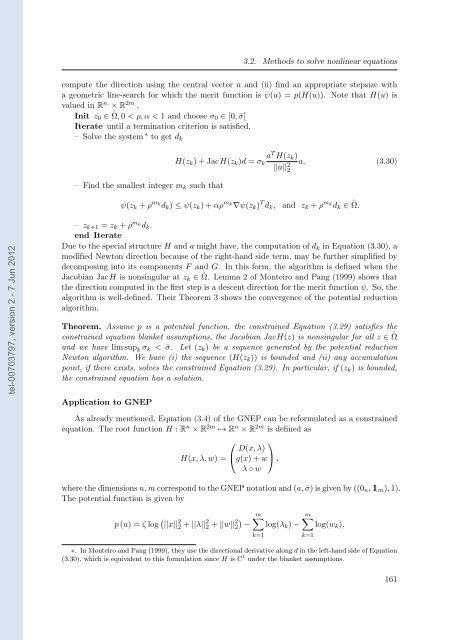Etude des marchés d'assurance non-vie à l'aide d'équilibres de ...
Etude des marchés d'assurance non-vie à l'aide d'équilibres de ...
Etude des marchés d'assurance non-vie à l'aide d'équilibres de ...
You also want an ePaper? Increase the reach of your titles
YUMPU automatically turns print PDFs into web optimized ePapers that Google loves.
tel-00703797, version 2 - 7 Jun 2012<br />
3.2. Methods to solve <strong>non</strong>linear equations<br />
compute the direction using the central vector a and (ii) find an appropriate stepsize with<br />
a geometric line-search for which the merit function is ψ(u) = p(H(u)). Note that H(u) is<br />
valued in R n. × R 2m. .<br />
Init z0 ∈ ˚ Ω, 0 < ρ, α < 1 and choose σ0 ∈ [0, ¯σ[<br />
Iterate until a termination criterion is satisfied,<br />
– Solve the system ∗ to get dk<br />
H(zk) + JacH(zk)d = σk<br />
– Find the smallest integer mk such that<br />
aT H(zk)<br />
||a|| 2 a. (3.30)<br />
2<br />
ψ(zk + ρ mk dk) ≤ ψ(zk) + αρ mk ∇ψ(zk) T dk, and zk + ρ mk dk ∈ ˚ Ω.<br />
– zk+1 = zk + ρ mkdk.<br />
end Iterate<br />
Due to the special structure H and a might have, the computation of dk in Equation (3.30), a<br />
modified Newton direction because of the right-hand si<strong>de</strong> term, may be further simplified by<br />
<strong>de</strong>composing into its components F and G. In this form, the algorithm is <strong>de</strong>fined when the<br />
Jacobian JacH is <strong>non</strong>singular at zk ∈ ˚ Ω. Lemma 2 of Monteiro and Pang (1999) shows that<br />
the direction computed in the first step is a <strong><strong>de</strong>s</strong>cent direction for the merit function ψ. So, the<br />
algorithm is well-<strong>de</strong>fined. Their Theorem 3 shows the convergence of the potential reduction<br />
algorithm.<br />
Theorem. Assume p is a potential function, the constrained Equation (3.29) satisfies the<br />
constrained equation blanket assumptions, the Jacobian JacH(z) is <strong>non</strong>singular for all z ∈ ˚ Ω<br />
and we have lim sup k σk < ¯σ. Let (zk) be a sequence generated by the potential reduction<br />
Newton algorithm. We have (i) the sequence (H(zk)) is boun<strong>de</strong>d and (ii) any accumulation<br />
point, if there exists, solves the constrained Equation (3.29). In particular, if (zk) is boun<strong>de</strong>d,<br />
the constrained equation has a solution.<br />
Application to GNEP<br />
As already mentioned, Equation (3.4) of the GNEP can be reformulated as a constrained<br />
equation. The root function H : R n × R 2m ↦→ R n × R 2m is <strong>de</strong>fined as<br />
⎛ ⎞<br />
D(x, λ)<br />
H(x, λ, w) = ⎝g(x)<br />
+ w⎠<br />
,<br />
λ ◦ w<br />
where the dimensions n, m correspond to the GNEP notation and (a, ¯σ) is given by ((0n, 1m), 1).<br />
The potential function is given by<br />
p (u) = ζ log ||x|| 2 2 + ||λ|| 2 2 + ||w|| 2 2 −<br />
m<br />
log(λk) −<br />
k=1<br />
m<br />
log(wk),<br />
∗. In Monteiro and Pang (1999), they use the directional <strong>de</strong>rivative along d in the left-hand si<strong>de</strong> of Equation<br />
(3.30), which is equivalent to this formulation since H is C 1 un<strong>de</strong>r the blanket assumptions.<br />
k=1<br />
161
















